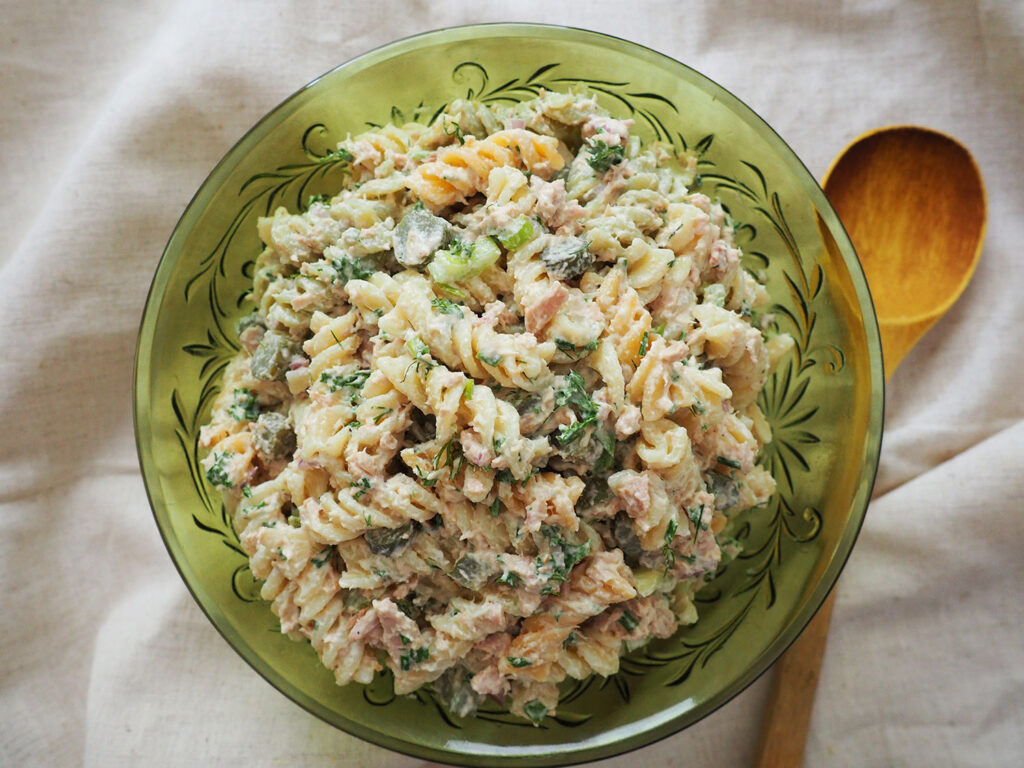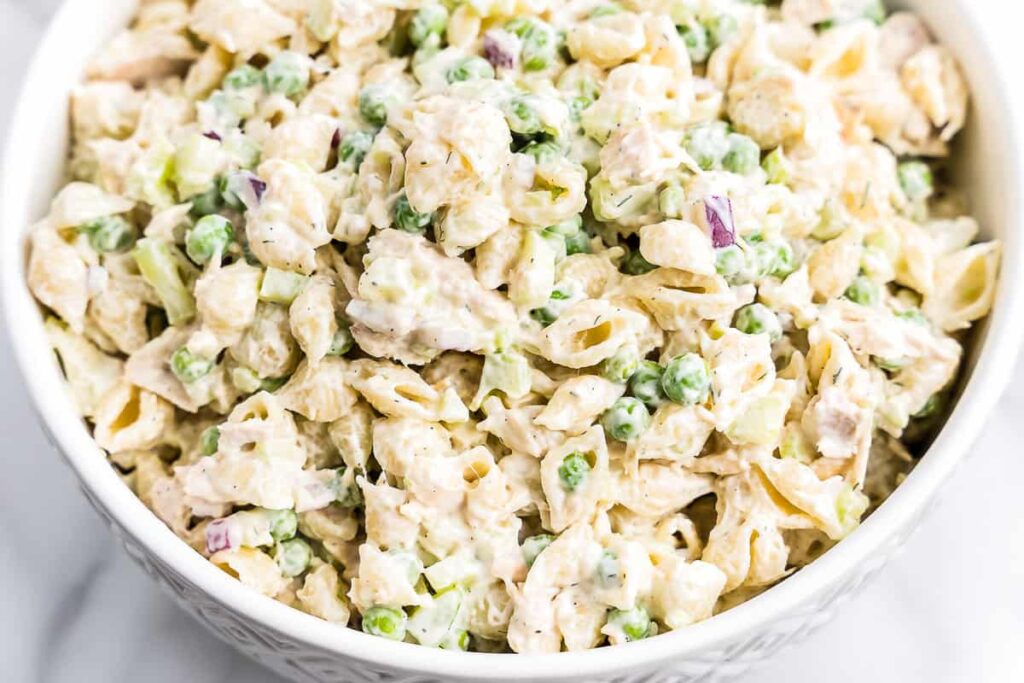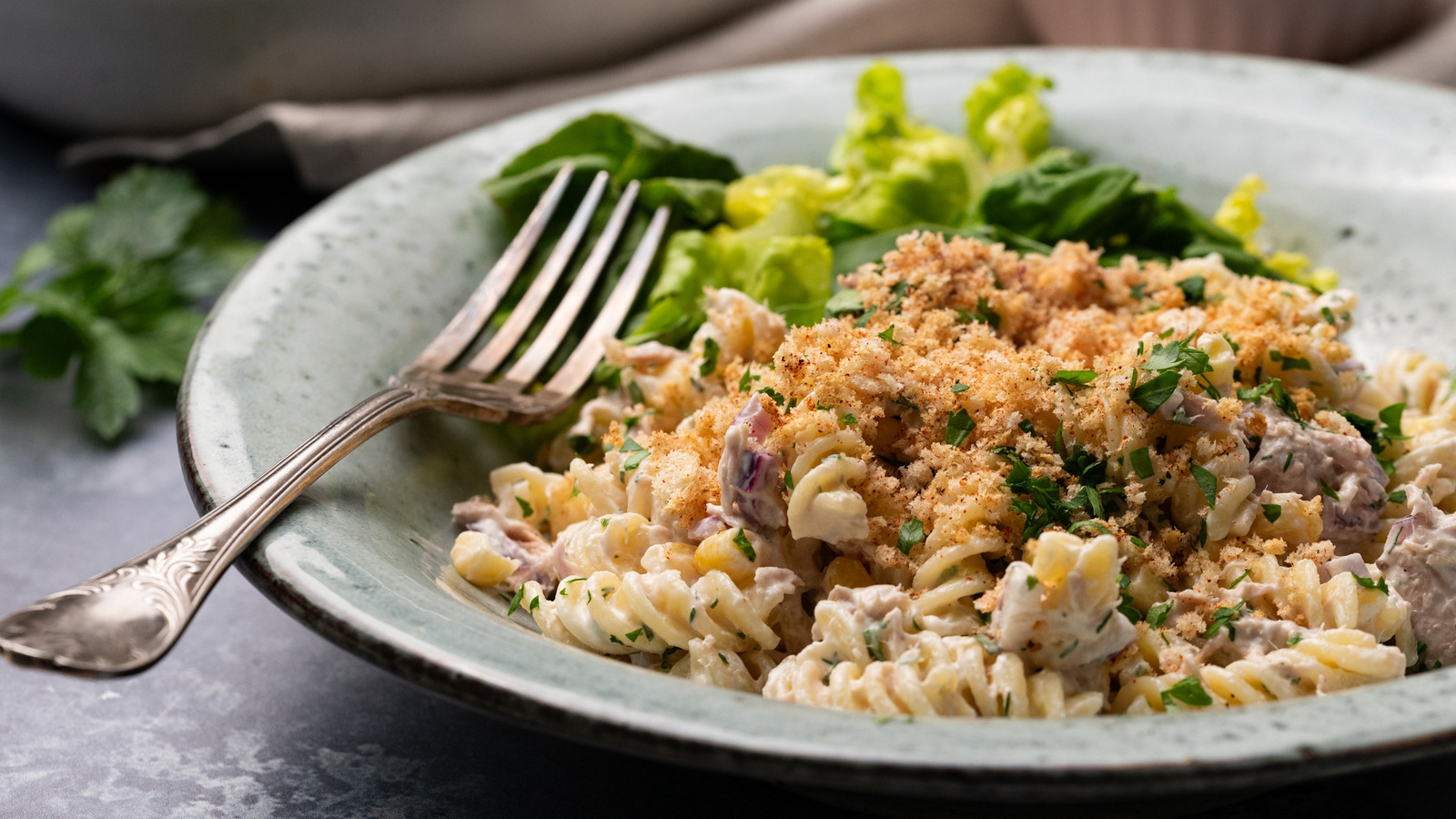Tuna pasta, when stored correctly in the fridge, typically remains safe to eat for about 3 to 5 days. The precise duration depends on several factors, such as the freshness of the ingredients used, the temperature of your refrigerator, and how well the pasta is sealed and stored.
To maximize its fridge life, ensure your tuna pasta is kept in an airtight container and placed in the coldest part of the fridge, ideally at or below 40°F (4°C). Be vigilant for any signs of spoilage, including changes in color, off-putting odors, or the presence of mold. If you encounter any of these indicators, it’s best to discard the pasta.
Remember that these are general guidelines, and variations may occur based on factors like the specific ingredients used and your fridge’s efficiency. Always rely on your senses and best judgment to determine if your tuna pasta is still safe to consume.
What Are The Factors That Influence Tuna Pasta’s Shelf Life?

The shelf life of tuna pasta, like any other food item, is influenced by several factors.
Ingredients Used
The type of ingredients in your tuna pasta can affect its shelf life. Fresh and high-quality ingredients tend to result in a longer shelf life.
For example, if you use fresh tuna, it may last longer than canned tuna due to its lower sodium content.
Preparation and Cooking
How the tuna pasta is prepared and cooked matters. Proper cooking and handling, along with maintaining hygiene during the preparation process, can reduce the risk of bacterial contamination and extend the pasta’s shelf life.
Storage Temperature
The temperature at which you store the tuna pasta is critical. Refrigeration is essential. Store it at or below 40°F (4°C) to slow down bacterial growth. Cold temperatures help prevent spoilage.
Storage Container
Using an airtight container is vital. Air exposure can lead to drying and the development of off-flavors. A good container also prevents contamination from other foods in the refrigerator.
Refrigeration Time
The longer tuna pasta is stored in the refrigerator, the greater the chance of spoilage. Freshly prepared pasta typically lasts 3 to 5 days, while pasta that’s been stored for an extended period may spoil sooner.
Contamination
Cross-contamination with utensils, cutting boards, or hands that have touched raw seafood or poultry can introduce harmful bacteria to the pasta. Ensure proper hygiene during food preparation to avoid contamination.
Preservatives
If your tuna pasta contains preservatives or additives, it may have a longer shelf life. However, these ingredients can also affect the taste and quality of the pasta.
Acidity
Acidic ingredients like tomatoes can act as natural preservatives and extend the shelf life of your tuna pasta.
Cooling
Allowing the pasta to cool completely at room temperature before refrigeration is important. Hot food can raise the temperature inside the fridge, potentially affecting other foods.
Reheating
Reheating tuna pasta to steaming hot temperatures before consuming it can kill any bacteria that may have developed during storage.
By considering these factors and following proper food safety practices, you can ensure your tuna pasta remains safe and enjoyable for an extended period. Always use your judgment and inspect the pasta for any signs of spoilage before consumption.
What are the Signs of Tuna Pasta Spoilage?
To ensure the safety and quality of your tuna pasta, it’s essential to be able to recognize signs of spoilage.
First of all, if your tuna pasta emits an off-putting or sour smell, it’s a clear sign of spoilage. Fresh pasta should have a pleasant aroma, while spoiled pasta may have a distinct, unpleasant odor.
Then, tuna pasta that has turned inedible often changes color. Look for any significant discoloration, such as a shift from vibrant to dull or the presence of unusual hues.
Also, the growth of mold on the surface of your tuna pasta is a definitive sign of spoilage. Mold can appear as spots or patches of different colors, including green, white, or black.
Remember, fresh tuna pasta has a firm yet tender texture. If the texture becomes overly mushy, slimy, or grainy, it has likely spoiled.
Taste is a reliable indicator of spoilage. If your tuna pasta tastes different from what you expect—perhaps sour, bitter, or generally unpleasant—it’s best to discard it.
In addition, the formation of gas bubbles or an unusual foamy texture in the pasta can indicate bacterial activity and spoilage.
If there’s a noticeable increase in liquid content in the container, it may be a result of moisture released during spoilage. This can dilute the flavors and ruin the dish.
Furthermore, inspect the packaging or container for signs of damage, such as broken seals or lids, which can expose the pasta to air and contaminants, leading to spoilage.
In summary, if you observe any of these signs, it’s safest to refrain from consuming the tuna pasta. Spoiled food can pose health risks, so exercising caution and promptly discarding potentially spoiled pasta is essential to ensure food safety.
How many times can you reheat tuna pasta?
The number of times you can safely reheat tuna pasta depends on how well you handle and store it. Generally, you can reheat tuna pasta multiple times as long as you follow these guidelines
Reheat Once
It’s safe to reheat your tuna pasta once after its initial cooking. Ensure that it’s reheated to a temperature of at least 165°F (73.9°C) to kill any bacteria that may have developed.
Refrigerate Promptly
After the first heating and serving, promptly refrigerate any leftovers. Ensure they are sealed in airtight containers to prevent bacterial growth.
Reheat Portions
When reheating, only warm the portion you intend to consume. Repeatedly heating and cooling the entire batch can affect quality and safety.
Consume Promptly
Ideally, consume the reheated tuna pasta within 2-3 days of the initial cooking to minimize the risk of spoilage.
Avoid Excessive Reheating
While you can reheat tuna pasta multiple times, it’s best to reheat only what you plan to eat. Excessive reheating can lead to overcooking and negatively impact taste and texture.
Remember to use your senses when assessing the quality of reheated tuna pasta. If it exhibits signs of spoilage, such as off-putting odors or changes in color, it’s safer to discard it rather than reheating again.
Proper handling, storage, and reheating practices are key to enjoying leftover tuna pasta safely and deliciously.
Can I put warm tuna pasta in the fridge?
It’s not advisable to put warm tuna pasta directly into the fridge. Hot or warm food can raise the temperature inside the refrigerator, potentially compromising the safety of other perishable items. To cool your tuna pasta safely before refrigeration, follow these steps
Allow it to Cool: Let the tuna pasta sit at room temperature for about 1-2 hours or until it reaches a safe temperature to handle (usually around 90°F or 32°C).
Divide into Smaller Portions: For faster cooling, consider dividing the pasta into smaller portions. This allows heat to dissipate more quickly.
Use the Two-Hour Rule: Refrigerate your pasta within two hours of cooking to prevent bacterial growth. If the room temperature is hot (above 90°F or 32°C), aim to refrigerate within one hour.
Cover and Seal: Once your tuna pasta has cooled to the desired temperature, place it in airtight containers and seal them securely to maintain freshness.
By following these steps, you’ll ensure your tuna pasta cools safely and can be stored in the fridge without jeopardizing the safety of other refrigerated items.
Does Refrigerating Tuna Pasta Reduce Calories?

Refrigerating tuna pasta does not inherently reduce its calorie content. The caloric value of the tuna pasta remains consistent whether it’s served fresh or after refrigeration.
A standard serving of tuna pasta (approximately 1 cup) typically contains about 336 calories. This portion includes 6 grams of fat, with 1 gram of saturated fat, and 17 milligrams of cholesterol. It also provides 51 grams of carbohydrates, 5 grams of dietary fiber, and 7 grams of total sugars, along with 18 grams of protein.
However, there can be some indirect factors that might influence calorie intake
Portion Control: Refrigerating tuna pasta allows you to control your portion sizes more effectively. By serving smaller portions when reheating, you can potentially reduce your calorie intake.
Changes in Ingredients: When reheating refrigerated tuna pasta, you might choose to add different ingredients or toppings. Depending on your choices, this could either increase or decrease the overall calorie content of the dish.
Texture and Flavor Alterations: The texture and flavor of refrigerated and reheated tuna pasta might differ from when it’s freshly made. These changes could influence your overall satisfaction and the quantity you consume, which can impact calorie intake.
In summary, the calorie content of tuna pasta remains the same, but refrigeration can offer opportunities for better portion control and creative adaptations that may affect your overall calorie consumption.
FAQ
Can you eat tuna pasta after 3 days?
Yes, tuna pasta can generally be safely consumed after 3 days if it has been stored properly. However, always check for signs of spoilage, like off-putting odors or changes in texture, before eating.
How many times can you reheat tuna pasta?
You can safely reheat tuna pasta multiple times as long as you follow proper handling and storage practices. However, over-reheating may affect its taste and texture.
Should I warm tuna pasta?
Warming tuna pasta before consumption is recommended for a better taste and experience. You can reheat it using a microwave, stovetop, or oven.
Can you reheat tuna pasta with mayo?
Yes, you can reheat tuna pasta with mayo. However, add a bit more mayo or a splash of liquid during reheating to maintain moisture.
Is reheated pasta more healthy?
Reheated pasta’s nutritional value remains largely the same. However, the quality and taste may differ due to changes in texture and moisture content.
Can you freeze and reheat tuna pasta?
Yes, you can freeze tuna pasta for longer storage. Thaw it in the refrigerator and reheat as needed. Freezing may slightly alter the texture.
Is it OK to reheat cold pasta?
It’s perfectly fine to reheat cold pasta. Warming it can enhance its taste and texture.
Can you reheat 5-day-old pasta?
Reheating 5-day-old pasta is generally safe if it’s been stored correctly. Always inspect for spoilage signs before consuming.
Can you reheat 2-day-old pasta?
Reheating 2-day-old pasta is safe if it’s been handled and stored properly. Always check for signs of spoilage before eating.
Is 5-day-old pasta OK to eat?
A 5-day-old pasta is generally safe to eat if it has been stored correctly, kept at a safe temperature, and shows no signs of spoilage. However, individual judgment is essential to ensure safety.
Final words
To finish it up, the shelf life of tuna pasta in the fridge may vary depending on several factors, but with proper handling and storage, you can enjoy it safely for a reasonable amount of time. Remember to cool it before refrigeration, use an airtight container, and maintain a cold temperature in the fridge.
Always check for signs of spoilage before consuming, and when in doubt, it’s better to be safe than sorry. By following these guidelines, you can savor your delicious tuna pasta without worry.

